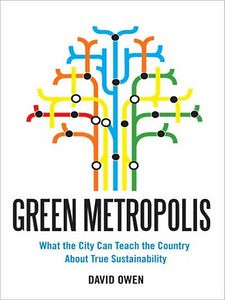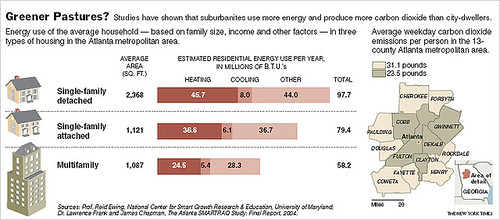New years post #8: Shattering the myths of sustainability
(Still have a few more posts to go in this series of entries marking the new year.)

Ratings systems, such as LEED, have a “fundamental weakness,” he thinks, as a “values-laden incentive system” that promotes individual buildings, particularly those produced by high-end developers.
Instead, we need to focus on systems of development more generally, in particular how land use impacts energy use, in particular transportation, and mass transit vs. personal transit.
In chapter after chapter, Owens punctures our myths surrounding the green movement with laser-guided precision in the hopes of clearing the air. His method is provocative, setting us up with teasers such as the following: “Most of the products, technologies, and practices popularly touted as sustainable are not sustainable at all.” Then he tells us, dispassionately, why. ...
With straightforward language and clarity of argument, a reportorial style rather than philosophical argument, Owens reminds us how much more efficient urban living can be. Rather than driving and expending petroleum-based fuel to reach the strip mall, the city dweller can often simply walk downstairs, or perhaps just down the block for the same purchase. The difference between a short walk and a long drive can be a major savings in energy usage and carbon footprint. And herein lies one of his major messages: In cities, large savings can occur regardless of the motivation of the citizen. It might seem unfair, but you don’t have to care to live more responsibly; the framework of urban life inevitably results in a more sustainable environment.
His points can be summarized as follows: In a world of finite resources, in which the actual number of human beings is increasing, our stewardship is best exercised by minimizing our footprint on the land. In other words, density offers the best solution for habitation. The density of cities, and the interdependencies they provide, point to the best solutions, rather than (sorry architects) designs for the most sustainable individual buildings, changes to energy recovery systems, or advances to the automobile — topics we expend a great deal of energy on ourselves. (If anything, he encourages less automobile usage, period, with greater reliance on mass transit or foot traffic.)
The point is not unlike Belmont's in Cities in Full, that recentralization of commerce, employment centers, housing, and transit is the best possible land use policy there is. And it supports the point that I make, that's in the first line in the introduction of the blog:
A community’s physical form, rather than its land uses, is its most intrinsic and enduring characteristic.
Ratings systems, such as LEED, have a “fundamental weakness,” he thinks, as a “values-laden incentive system” that promotes individual buildings, particularly those produced by high-end developers.
Instead we need to focus on land use development as a system, and refocus the system on reducing energy use, that means towards compact development forms which support sustainable transportation--walking, biking, and transit.
As David Engwicht points out in Reclaiming Our Towns and Cities, cities were created to promote exchange of all types, and simultaneously, to reduce our need to travel in order to accomplish exchange. So land use and transportation policies shouldn't treat all forms of mobility as equal, but should be focused on reducing the need for motorized travel generally, but especially the automobile, which from a systems standpoint, requires massive inputs of land, roadway, energy, and other resources, when compared to the resource requirements of walking, biking, and transit.

Labels: energy, green-environment-urban, urban design/placemaking, urban vs. suburban





0 Comments:
Post a Comment
<< Home